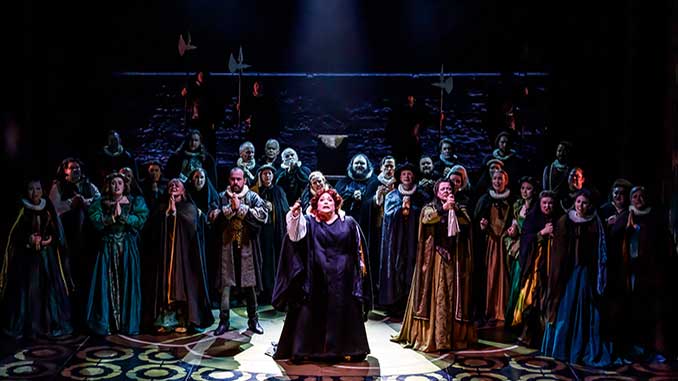 Returning to ‘bel canto’ repertoire after successfully mounting the gargantuan task of a Wagner Ring in Bendigo earlier in the year, Melbourne Opera’s (MO) hard work, passion and dedication to the opera community is on show once again.
Returning to ‘bel canto’ repertoire after successfully mounting the gargantuan task of a Wagner Ring in Bendigo earlier in the year, Melbourne Opera’s (MO) hard work, passion and dedication to the opera community is on show once again.
Top to bottom, note to note and awash with spine-tingling tension, Saturday’s opening night of Italian composer Gaetano Donizetti’s Maria Stuarda thrilled completely.
In a welcome revival of director Suzanne Chaundy’s evocative 2015 production, every ingredient comes together in what might be considered the company’s best-cast and most polished work at the Athenaeum Theatre.
Mary, Queen of Scots and her cousin Queen Elizabeth I – two rival queens who never met in real life but who come face to face in a dramatic master stroke by Frederich Schiller in his 1800 play, Maria Stuart – form the basis for Donizetti’s two-act tragic opera which premiered in 1835 at La Scala.
Amongst royal settings, political power struggles and Catholic-Protestant warring, a personal, quasi domestic tragedy plays out over Donizetti’s gloriously impactful score, sumptuously brought to life by conductor Raymond Lawrence.
Under Lawrence, the MO Orchestra gleamed on opening night, the strings working their atmospheric duties and momentum tirelessly, while the woodwinds revealed particularly strong colours.
Two tremendous sopranos meet for the confrontation between the hostile queens – the formidable Helena Dix as Mary and ascending star Eleanor Greenwood as Elizabeth.
The first half belongs to Elizabeth, her power-hungry and scornful nature impressively realised by Greenwood’s debut leading role for MO. There will, undoubtedly and hopefully, be many to come.
Making the change from mezzo-soprano, Greenwood’s rich, penetrating and fleshy soprano is perfectly suited to Elizabeth’s dark domination. That Greenwood appears to effortlessly embrace the pit, perform convincingly in every situation and convey great emotion to her audience, is a sign of an exciting career ahead.
Having Dix back in her beloved Melbourne, be it temporarily, is a special joy. Dix’s contribution to the health of local opera cannot be overlooked, and so too the extraordinary beauty of tone and affecting heart she portrays as Mary.
In her entrance scene, as Mary reflects on her early years in France, Oh nube! che lieve per l’aria t’aggiri (Oh cloud, that wanders light upon the breeze) is a stunning entree of soul-baring emotion and superbly controlled technique.
Dix follows up with a gale of splendorous coloratura in a cabaletta full of disdain for her rival. Thereon, Mary’s sense that no one has any pity for her as an execution looms seems anything but for her off-stage audience.
Dix digs deep for the pity and humanity Donizetti desired – Catholics rejoice – and nothing better than a massed prayer, to which Dix explodes in vocal magnificence in one of numerous highlights, guarantees it.
The two contrasted queens are aided well by four supporting soloists and the resplendent sound of the MO Chorus.
Henry Choo excellently reprises the role of Robert, Earl of Leicester, his flexing lyrical tenor comfortably adapting to a heart that requires careful consideration of the delicate circumstances his character inhabits.
Also reprising his role and impatiently eager for Mary’s execution as Lord Cecil, bass Eddie Muliaumaseal’li lurks heavily at Elizabeth’s side, a potent presence bonded with his authoritative and sonorous bass.
Ardent baritone Christopher Hillier sings with highly pressurised purpose as Mary’s loyal messenger Talbot, Earl of Shrewsbury and mezzo-soprano Caroline Vercoe brings sympathetic support as Maria’s companion, Anna.
Undecidedly elegant or garish, a wealth of showy silk, satin and fur by the late Jennie Tate for Opera Australia dress the central conflict with Christina Logan-Bell’s minimal but most effective set design drawing inspiration from the emblematic Tudor rose.
Peter Amesbury’s lighting is crafted for maximum dramatic effect with stunning use of chiaroscuro. And the barest of stage furnishings – first a throne, then a desk and chair and finally the chopping block – are cleverly utilised while providing scope for movement within the limited space.
With subtle improvements on 2015’s premiere production, Chaundy brings added vitality to the drama on several levels, notably in an active chorus that live in the moment without overpowering the focus and a compelling confrontation scene built on centripetal forces.
Every force excels in this revival and, while Maria Stuarda – or a library full of scores for that matter – cannot be relied upon for historical accuracy, it certainly has a way of distorting history sublimely. Especially so when two wondrously talented sopranos come face to face.
Maria Stuarda
Athenaeum Theatre, 188 Collins Street, Melbourne
Performance: Saturday 9 September 2023
Season continues to 17 September 2023
Bookings: www.ticketmaster.com.au
For more information, visit: www.melbourneopera.com for details.
Image: Helena Dix as Maria Stuarda with the Melbourne Opera Chorus – photo by Robin Halls
Review: Paul Selar
